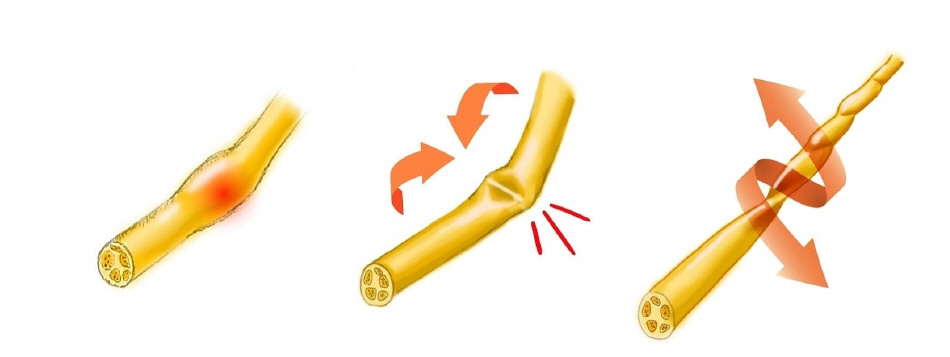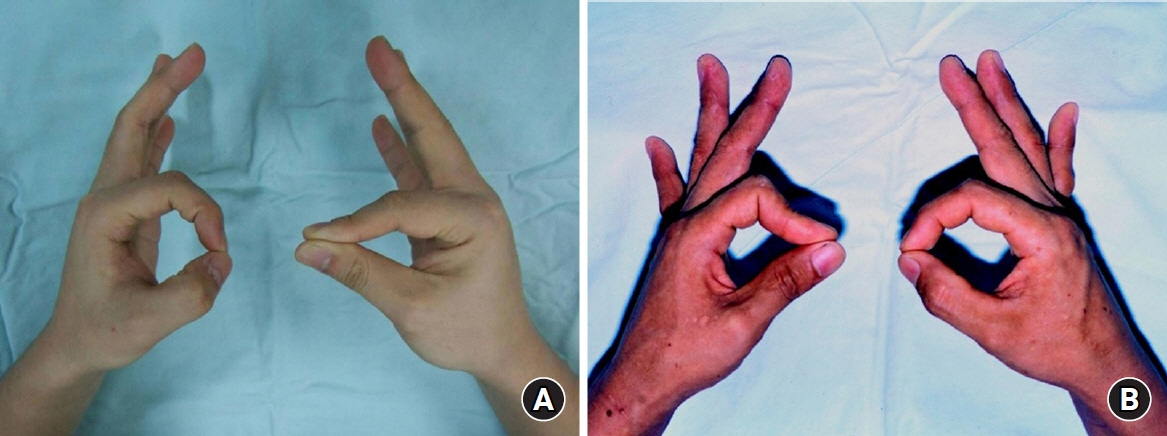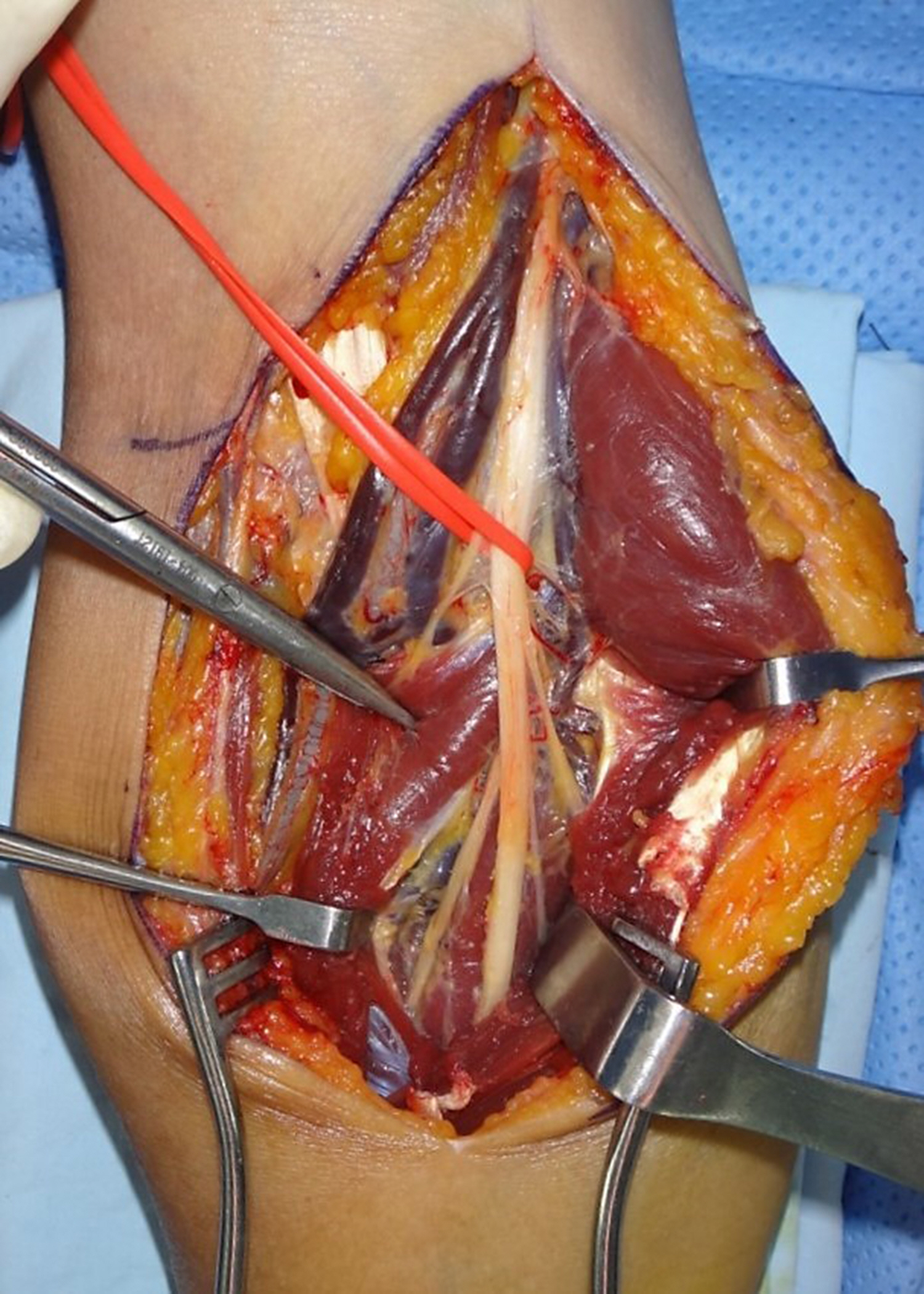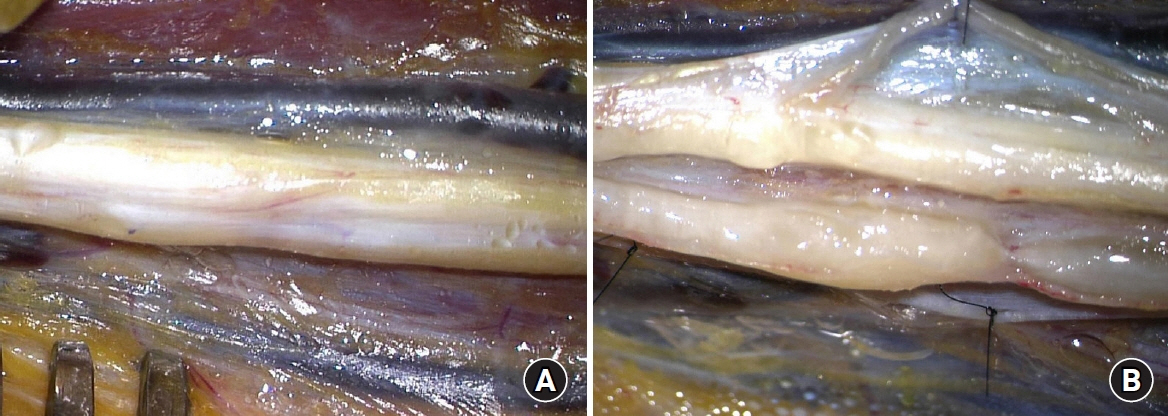Arch Hand Microsurg.
2021 Sep;26(3):199-208. 10.12790/ahm.21.0100.
Current Concepts of Anterior Interosseous Nerve Syndrome
- Affiliations
-
- 1Department of Orthopaedic Surgery, Daegu Catholic University Hospital, Daegu Catholic University of Korea College of Medicine, Daegu, Korea
- 2Department of Orthopaedic Surgery, Bucheon St. Mary’s Hospital, College of Medicine, The Catholic University of Korea, Seoul, Korea
- KMID: 2519474
- DOI: http://doi.org/10.12790/ahm.21.0100
Abstract
- The causes and treatment of anterior interosseous nerve syndrome have not been established yet. Two causes are known, as a result of compressive neuropathy and as a result of neuralgic amyotrophy. An hourglass-like constriction found in the main trunk of the median nerve suggests a new paradigm for the cause and treatment of anterior interosseous nerve syndrome. It is necessary to differentiate it from other diseases through a meticulous physical examination, and surgical treatment is recommended only when there are no other related neurological lesions and no improvement despite conservative treatment for more than 6 months.
Figure
Reference
-
1. Tinel J, Rothwell F, Joll CA, Schlesinger EB. Nerve wounds: symptomatology of peripheral nerve lesions caused by war wounds. London: Baillière, Tindall & Cox;1918.2. Parsonage MJ, Turner JW. Neuralgic amyotrophy; the shoulder-girdle syndrome. Lancet. 1948; 1:973–8.
Article3. Kiloh LG, Nevin S. Isolated neuritis of the anterior interosseous nerve. Br Med J. 1952; 1:850–1.
Article4. Spinner M. The anterior interosseous-nerve syndrome, with special attention to its variations. J Bone Joint Surg Am. 1970; 52:84–94.5. Saeed MA, Gatens PF. Anterior interosseous nerve syndrome: unusual etiologies. Arch Phys Med Rehabil. 1983; 64:182.6. Pavesi G, Medici D, Mancia D. Anterior interosseous nerve syndrome secondary to forearm thrombo-phlebitis. Ital J Neurol Sci. 1989; 10:221.
Article7. Gainor BJ, Olson S. Combined entrapment of the median and anterior interosseous nerves in a pediatric both-bone forearm fracture. J Orthop Trauma. 1990; 4:197–9.
Article8. Geissler WB, Fernandez DL, Graca R. Anterior interosseous nerve palsy complicating a forearm fracture in a child. J Hand Surg Am. 1990; 15:44–7.
Article9. Proudman TW, Menz PJ. An anomaly of the median artery associated with the anterior interosseous nerve syndrome. J Hand Surg Br. 1992; 17:507–9.
Article10. Cramer KE, Green NE, Devito DP. Incidence of anterior interosseous nerve palsy in supracondylar humerus fractures in children. J Pediatr Orthop. 1993; 13:502–5.
Article11. Huang K, Pun WK, Coleman S. Entrapment and transection of the median nerve associated with greenstick fractures of the forearm: case report and review of the literature. J Trauma. 1998; 44:1101–2.12. Mackinnon SE, Novak CB. Compression neuropathies. In : Green DP, Wolfe SW, editors. Green’s operative hand surgery. Philadelphia, PA: Elsevier;2011. p. 977–1014.13. Sneag DB, Arányi Z, Zusstone EM, et al. Fascicular constrictions above elbow typify anterior interosseous nerve syndrome. Muscle Nerve. 2020; 61:301–10.
Article14. Strohl AB, Zelouf DS. Ulnar tunnel syndrome, radial tunnel syndrome, anterior interosseous nerve syndrome, and pronator syndrome. J Am Acad Orthop Surg. 2017; 25:e1–10.
Article15. Fearn CB, Goodfellow JW. Anterior interosseous nerve palsy. J Bone Joint Surg Br. 1965; 47:91–3.
Article16. Hill NA, Howard FM, Huffer BR. The incomplete anterior interosseous nerve syndrome. J Hand Surg Am. 1985; 10:4–16.
Article17. Spinner M, Schreiber SN. Anterior interosseous-nerve paralysis as a complication of supracondylar fractures of the humerus in children. J Bone Joint Surg Am. 1969; 51:1584–90.
Article18. van Alfen N, van Engelen BG. The clinical spectrum of neuralgic amyotrophy in 246 cases. Brain. 2006; 129(Pt 2):438–50.
Article19. Gstoettner C, Mayer JA, Rassam S, et al. Neuralgic amyotrophy: a paradigm shift in diagnosis and treatment. J Neurol Neurosurg Psychiatry. 2020; 91:879–88.
Article20. ArÁnyi Z, Csillik A, DéVay K, et al. Ultrasonography in neuralgic amyotrophy: sensitivity, spectrum of findings, and clinical correlations. Muscle Nerve. 2017; 56:1054–62.
Article21. Milner CS, Kannan K, Iyer VG, Thirkannad SM. Parsonage-Turner syndrome: clinical and epidemiological features from a hand surgeon's perspective. Hand (N Y). 2016; 11:227–31.22. Werner CO. The anterior interosseous nerve syndrome. Int Orthop. 1989; 13:193–7.23. Sood MK, Burke FD. Anterior interosseous nerve palsy. A review of 16 cases. J Hand Surg Br. 1997; 22:64–8.24. Park IJ, Roh YT, Jeong C, Kim HM. Spontaneous anterior interosseous nerve syndrome: clinical analysis of eleven surgical cases. J Plast Surg Hand Surg. 2013; 47:519–23.
Article25. Na KT, Jang DH, Lee YM, Park IJ, Lee HW, Lee SU. Anterior interosseous nerve syndrome: is it a compressive neuropathy? Indian J Orthop. 2020; 54(Suppl 1):193–8.26. Nagano A, Shibata K, Tokimura H, Yamamoto S, Tajiri Y. Spontaneous anterior interosseous nerve palsy with hourglass-like fascicular constriction within the main trunk of the median nerve. J Hand Surg Am. 1996; 21:266–70.
Article27. Nagano A. Spontaneous anterior interosseous nerve palsy. J Bone Joint Surg Br. 2003; 85:313–8.
Article28. Lundborg G. Commentary: hourglass-like fascicular nerve compressions. J Hand Surg Am. 2003; 28:212–4.
Article29. Arányi Z, Csillik A, Dévay K, et al. Ultrasonographic identification of nerve pathology in neuralgic amyotrophy: enlargement, constriction, fascicular entwinement, and torsion. Muscle Nerve. 2015; 52:503–11.
Article30. Chhabra A, Madhuranthakam AJ, Andreisek G. Magnetic resonance neurography: current perspectives and literature review. Eur Radiol. 2018; 28:698–707.
Article31. Madhuranthakam AJ, Lenkinski RE. Technical advancements in MR neurography. Semin Musculoskelet Radiol. 2015; 19:86–93.
Article32. Sneag DB, Saltzman EB, Meister DW, Feinberg JH, Lee SK, Wolfe SW. MRI bullseye sign: an indicator of peripheral nerve constriction in parsonage-turner syndrome. Muscle Nerve. 2017; 56:99–106.
Article33. Du R, Auguste KI, Chin CT, Engstrom JW, Weinstein PR. Magnetic resonance neurography for the evaluation of peripheral nerve, brachial plexus, and nerve root disorders. J Neurosurg. 2010; 112:362–71.
Article34. Krishnan KR, Sneag DB, Feinberg JH, Wolfe SW. Anterior interosseous nerve syndrome reconsidered: a critical analysis review. JBJS Rev. 2020; 8:e2000011.35. Seror P. Anterior interosseous nerve lesions. Clinical and electrophysiological features. J Bone Joint Surg Br. 1996; 78:238–41.36. Alderman AK, Chung KC. Incomplete anterior interosseous nerve syndrome: use of tendon transfer to expedite recovery. Ann Plast Surg. 2001; 47:682–3.
Article37. Mahring M, Semple C, Gray IC. Attritional flexor tendon rupture due to a scaphoid non union imitating an anterior interosseous nerve syndrome: a case report. J Hand Surg Br. 1985; 10:62–4.38. Mody BS. A simple clinical test to differentiate rupture of flexor pollicis longus and incomplete anterior interosseous paralysis. J Hand Surg Br. 1992; 17:513–4.
Article39. Melton JT, Murray JR, Lowdon IM. A simple clinical test of flexor pollicis longus rupture. J Hand Surg Br. 2005; 30:624–5.
Article40. Wong L, Dellon AL. Brachial neuritis presenting as anterior interosseous nerve compression: implications for diagnosis and treatment: a case report. J Hand Surg Am. 1997; 22:536–9.41. Futami T, Kobayashi A, Itoman M, Shimajiri I, Fujita T. Clinical investigation on the anterior interosseous nerve syndrome. J Jpn Soc Surg Hand. 1993; 10:338–41.42. Goyal M, Goyal K, Narkeesh K, Samuel AJ, Sharma S, Chatterjee S. The strain: counter strain technique in the management of anterior interosseous nerve syndrome. A case report. J Taibah Univ Med Sci. 2016; 12:70–4.43. Schantz K, Riegels-Nielsen P. The anterior interosseous nerve syndrome. J Hand Surg Br. 1992; 17:510–2.
Article
- Full Text Links
- Actions
-
Cited
- CITED
-
- Close
- Share
- Similar articles
-
- The Anterior Interosseous Nerve Syndrome
- Anterior Interosseous Nerve Syndrome following Bowling: A case report
- Bilateral Anterior Interosseous Nerve Syndrome: A Case Report
- Anterior Interosseous Nerve Syndrome with Varient Nerve Innervation: A Case Report
- Simultaneous Anterior and Posterior Interosseous Nerve Syndrome Following Shoulder Arthroscopy in the Lateral Decubitus Position: Case Report







